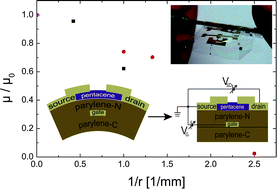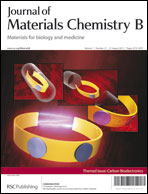Towards flexible organic thin film transistors (OTFTs) for biosensing
Abstract
We have studied parylene-N and parylene-C for their use as substrates and gate dielectrics in OTFTs. Parylene-N films with a thickness of 300 nm show the required dielectric properties, as verified by breakthrough-voltage measurements. The surface roughness measured for 300 nm thick parylene-N films is 4–5 nm. However, initial growth of parylene depends on the subjacent surface. This results in different thicknesses on Au electrodes and substrate materials for thin films. Capping of micro-patterned Au-electrodes with a thin Al layer via lift-off results in homogenous parylene film thickness on the whole sample surface. OTFTs are fabricated on glass with parylene-N as a gate dielectric and

- This article is part of the themed collection: Carbon Bioelectronics

 Please wait while we load your content...
Please wait while we load your content...